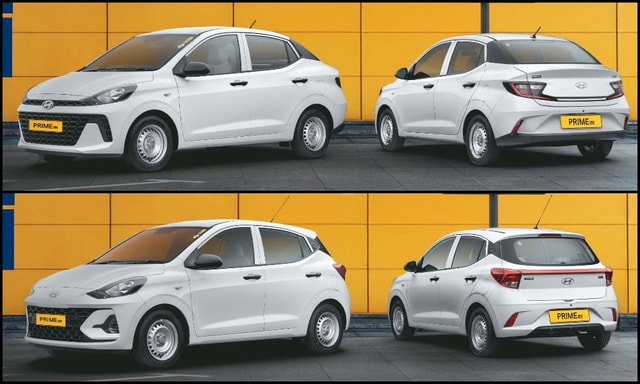Explained: Tyre Pressure Monitoring Systems

- TPMS informs the driver about an underinflated tyre or a puncture
- There are 2 Tyre Pressure Monitoring Systems - Indirect & Direct
- Cars like the i20, Sonet, Seltos, EcoSport get Direct TPMS in India
Back in the day when cars were more about clunking metal and less of electronics, there was no real way of knowing about a flat tyre before you actually got one. You either had to have a keen eye or use a pressure gauge to check the air pressure on the wheel. However, the array of sensors on newer cars give a great deal of information about the parts that have an issue or may need a repair or replacement. One such feature that has increasingly become popular is the Tyre Pressure Monitoring System (TPMS). The feature essentially tells you about the air pressure in your tyre, red-flagging a potential issue beforehand. As more and more mass-market cars get this feature, we explain what TPMS is, how it works and why you need it.
Also Read: Spare Wheels To Become Optional On Cars With Tubeless Tyres And TPMS: MoRTH

TPMS has been largely restricted to premium and luxury cars, but the feature is now becoming increasingly common on mass-market offerings
What Is TPMS?
Improper wheel alignment, punctures, broken roads or a damaged alloy wheel, there are several reasons that can affect your tyre's ability to maintain pressure resulting in a flat. The Tyre Pressure Monitoring System works with a host of specialised sensors that will tell you about a deflating tyre or a puncture. While the older cars with the TPMS feature showed only the warning indicator on the instrument cluster, newer cars are able to tell you the exact pressure levels on each of the tyres.
Types Of TPMS
The difference between an indicator and individual tyre levels comes from two different types of tyre pressure monitoring systems - Indirect TPMS and Direct TPMS. Here's a breakdown of how each of these work.

Cars with Indirect TPMS show the indicator on the instrument console but not the exact tyre pressure on each wheel
Indirect TPMS
More affordable and easier to maintain, an indirect TPMS is essentially a set of speed sensors that are used by the Anti-Lock Brakes (ABS) system. The sensors measure the rate of revolution each wheel is making, which then sends data to the onboard computer system to determine whether the tyre is losing pressure. The computer compares the data from one wheel to another and based on the rate of revolution of each wheel, it determines which wheel is spinning faster than the other. When a wheel is spinning faster than expected, the computer concludes that the tyre is underinflated, which prompts the TPMS indicator on the instrument console.
Ideally, Indirect TPMS activates when the tyre pressure is below 25 per cent of the recommended level. That's why it's not the most accurate representation of a deflated tyre. Moreover, when all four tyres are underinflated, the indirect TPMS will not be able to gauge the same and assumes the tyre pressure is fine.
An indirect TPMS unit will need to be reset after every tyre rotation or inflation. Ideally, it takes about 20 minutes after the car starts running for the indirect TPMS to determine whether all four tyres are evenly inflated for the indicator to stop showing on the console. It will also be unreliable if you choose to upsize or downsize your tyres or if the tyres are unevenly worn out. Nevertheless, the feature remains largely maintenance-free through the car's shelf life.

The direct tyre pressure monitoring system will accurately display the air pressure of each tyre
Direct TPMS
Coming to the expensive version, Direct TPMS as the name suggests provides a more accurate reading of the tyre pressure on your car. Unlike indirect TPMS that relies on ABS sensors, a direct TPMS unit uses pressure monitoring sensors that are located within each tyre.
The more advanced sensors not only read the tyre pressure but tyre temperature as well. All of this data is then sent wirelessly to a centralised control module in the car. The system registers whether any of the tyres are low on pressure and the data accordingly illuminates on your multi-information display (MID). Considering that each sensor has a unique serial number, the system is able to determine which tyre is underinflated and to what is the exact pressure reading.
Direct TPMS is more accurate and reliable in terms of data and does not need too much effort when it comes to maintenance. The sensor is placed inside the valve stem of the tyre and comes with its own battery that will last about a decade. Unlike indirect TPMS, these sensors do not need to be reset after every inflation.
However, Direct TPMS also comes with its own set of shortfalls. Apart from the fact that these are fairly more expensive, they also cannot be serviced by regular mechanics. Synchronising Direct TPMS requires specialised tools, which needs to be after tyre rotation or replacement. However, it's still a simpler process. Lastly, once the battery is completely discharged on the module, the entire unit needs to be replaced.

Failure of a wheel sensor may require the part to be replaced and needs to be done by the OEM technician
What Happens When TPMS Fails?
If the Indirect TPMS fails, the indicator on the console will be glowing constantly irrespective of the tyre pressure. In some cars, the letters 'TPMS' light up as well, which is a clear indicator of the system failing. With Direct TPMS, the system will also show warning lights on the MID unit along with the service reminder indicator. In case of the sensors failing, only the affected tyre's sensor may have to be replaced and then synchronised with the car's system.
Is Aftermarket TPMS A Good Buy?
There are several ancillary players that are offering aftermarket TPMS for older cars. Some of these systems are in fact better than OEM units, especially if the car has a factory-fitted Indirect TPMS. These kits ideally come with four sensors that are installed onto the valve stem of your wheel. A separate display installed on the dashboard shows the pressure reading for each individual tyre. There are different aftermarket TPMS kits available online with prices ranging between Rs. 3,000 and Rs. 12,000.
What's Next In TPMS Tech?

Bridgestone and Microsoft are working on TDMS that learns about broken roads and will inform other cars about the same
The technology that makes tyre pressure monitoring systems possible is evolving, especially with cars becoming more connected than ever. More recently, automaker BMW and tyre maker Michelin collaborated on the connected tyre that uses sensors to not only measure the air pressure but also the temperature inside.
Another interesting tech has been developed by Microsoft and Bridgestone that have come together to develop a system that monitors tyre pressure as well as damage. The Tyre Damage Monitoring System (TDMS) will detect if the tyre hit a pothole or other undulation on roads, and will tag the same using GPS. The system will then inform other cars via vehicle-to-vehicle communication about the imperfection at that spot.

Maintaining the correct air pressure will improve your car's performance, fuel economy and extend the tyre life | Photo Credit: Pexels.com
Why Should You Maintain Correct Tyre Pressure?
A TPMS kit does not absolve you from regularly maintaining your car's tyre pressure. While it may not seem like a big issue, an underinflated tyre can affect your car's performance and fuel economy, while also eroding the life of the tyre itself. An underinflated will not also absorb shock well, which will further add pressure on the suspension set-up.
TPMS then contributes to a better driving experience and definitely should be on your consideration list when looking for essential features on your next car. Moreover, OEMs that offer TPMS, tubeless tyres and a puncture repair kit do not need to provide a spare wheel as well, under the new regulations.
Latest News
 Jaiveer Mehra | Dec 31, 2025Hyundai Creta Sales Cross 2 Lakh Units In CY2025Carmaker said the Creta diesel still accounts for over 40 per cent of all units sold, while the share of first time buyers stands at over 30 per cent.1 min read
Jaiveer Mehra | Dec 31, 2025Hyundai Creta Sales Cross 2 Lakh Units In CY2025Carmaker said the Creta diesel still accounts for over 40 per cent of all units sold, while the share of first time buyers stands at over 30 per cent.1 min read Carandbike Team | Dec 30, 2025Hyundai Aura, Nios-Based Prime SD & Prime HB Taxis Launched In IndiaCarmaker rebrands fleet models under the Hyundai Prime brand rather than as separate variants of its passenger car range, as it previously did with the Xcent1 min read
Carandbike Team | Dec 30, 2025Hyundai Aura, Nios-Based Prime SD & Prime HB Taxis Launched In IndiaCarmaker rebrands fleet models under the Hyundai Prime brand rather than as separate variants of its passenger car range, as it previously did with the Xcent1 min read car&bike Team | Dec 30, 2025VinFast's V-Green Partners With Hindustan Petroleum To Setup EV Charging StationsV-Green is owned by Pham Nhat Vuong, Chairman of Vingroup Corporation and founder of VinFast.1 min read
car&bike Team | Dec 30, 2025VinFast's V-Green Partners With Hindustan Petroleum To Setup EV Charging StationsV-Green is owned by Pham Nhat Vuong, Chairman of Vingroup Corporation and founder of VinFast.1 min read Jafar Rizvi | Dec 30, 20252026 Kawasaki Versys 650, Vulcan S, Z650RS Launched: Now E20 CompatibleKawasaki has updated its 650cc range of motorcycles with E20 fuel compatibility and is offering new paint schemes.1 min read
Jafar Rizvi | Dec 30, 20252026 Kawasaki Versys 650, Vulcan S, Z650RS Launched: Now E20 CompatibleKawasaki has updated its 650cc range of motorcycles with E20 fuel compatibility and is offering new paint schemes.1 min read car&bike Team | Dec 29, 2025JSW MG Motor India Extends Assured Buyback Plan To 5 YearsMG has expanded its EV buyback programme, which is also offered for commercial MG ZS EV owners.1 min read
car&bike Team | Dec 29, 2025JSW MG Motor India Extends Assured Buyback Plan To 5 YearsMG has expanded its EV buyback programme, which is also offered for commercial MG ZS EV owners.1 min read car&bike Team | Dec 29, 2025Ducati XDiavel V4 Launched In India At Rs 30.89 LakhThe XDiavel V4 sits as a cruiser in the Diavel range and will be sold alongside the standard model.2 mins read
car&bike Team | Dec 29, 2025Ducati XDiavel V4 Launched In India At Rs 30.89 LakhThe XDiavel V4 sits as a cruiser in the Diavel range and will be sold alongside the standard model.2 mins read
 Preetam Bora | Dec 30, 2025TVS Orbiter Review: Real-World Performance and Range TestedThe TVS Orbiter is a promising electric scooter promising decent range, practicality and pricing. But is there any reason to avoid it? We spent a few days getting to know it better.9 mins read
Preetam Bora | Dec 30, 2025TVS Orbiter Review: Real-World Performance and Range TestedThe TVS Orbiter is a promising electric scooter promising decent range, practicality and pricing. But is there any reason to avoid it? We spent a few days getting to know it better.9 mins read Jafar Rizvi | Dec 24, 2025MG Windsor EV 38 kWh Long-Term Report: IntroductionThe Windsor EV has joined our garage, and before it settles into daily duty, I took it out to get a sense of what living with an electric car is like.4 mins read
Jafar Rizvi | Dec 24, 2025MG Windsor EV 38 kWh Long-Term Report: IntroductionThe Windsor EV has joined our garage, and before it settles into daily duty, I took it out to get a sense of what living with an electric car is like.4 mins read Seshan Vijayraghvan | Dec 23, 20252026 Kia Seltos Review: Formula Is Spot On, But Is The Timing Right?The 2nd-gen Kia Seltos has arrived, but it has the challenge of facing strong rivals like the Victoris and Sierra. The question is simple - Does it still have what it takes?9 mins read
Seshan Vijayraghvan | Dec 23, 20252026 Kia Seltos Review: Formula Is Spot On, But Is The Timing Right?The 2nd-gen Kia Seltos has arrived, but it has the challenge of facing strong rivals like the Victoris and Sierra. The question is simple - Does it still have what it takes?9 mins read car&bike Team | Dec 26, 2025Tata Punch EV Long-Term Second Report: Highway Performance, Pros & ConsAfter a week of living with the Tata Punch EV Long Range—including a proper Mumbai-Nashik highway test—we've learned what this little electric SUV is really made of.1 min read
car&bike Team | Dec 26, 2025Tata Punch EV Long-Term Second Report: Highway Performance, Pros & ConsAfter a week of living with the Tata Punch EV Long Range—including a proper Mumbai-Nashik highway test—we've learned what this little electric SUV is really made of.1 min read Seshan Vijayraghvan | Dec 22, 20252026 Tata Harrier & Safari 1.5 Hyperion Review: By The Power Of Petrol!The new Tata Harrier and Safari petrol packs a new 1.5-litre TGDI Hyperion engine, but is it an ideal alternative to the diesel version?7 mins read
Seshan Vijayraghvan | Dec 22, 20252026 Tata Harrier & Safari 1.5 Hyperion Review: By The Power Of Petrol!The new Tata Harrier and Safari petrol packs a new 1.5-litre TGDI Hyperion engine, but is it an ideal alternative to the diesel version?7 mins read





















































































































